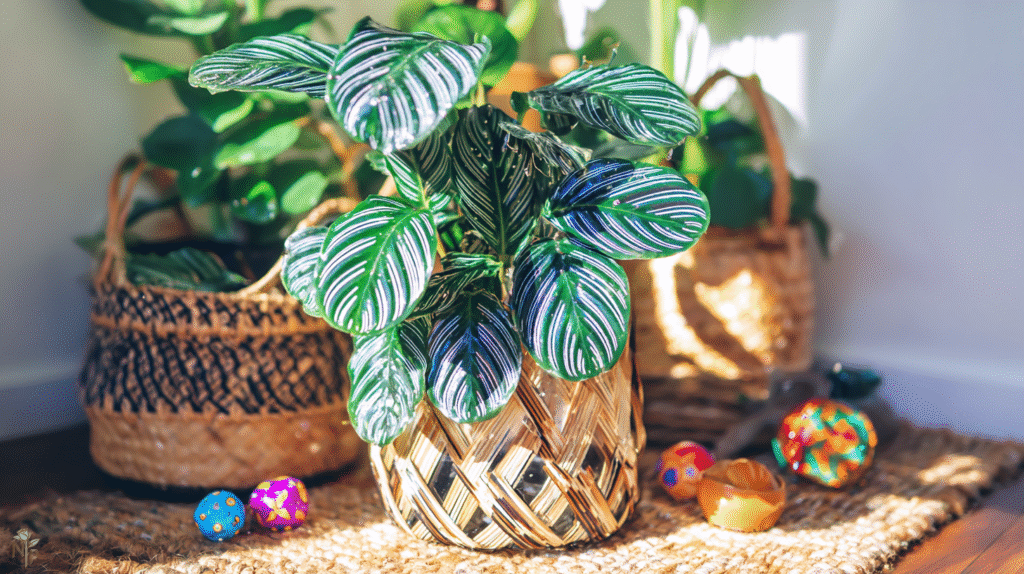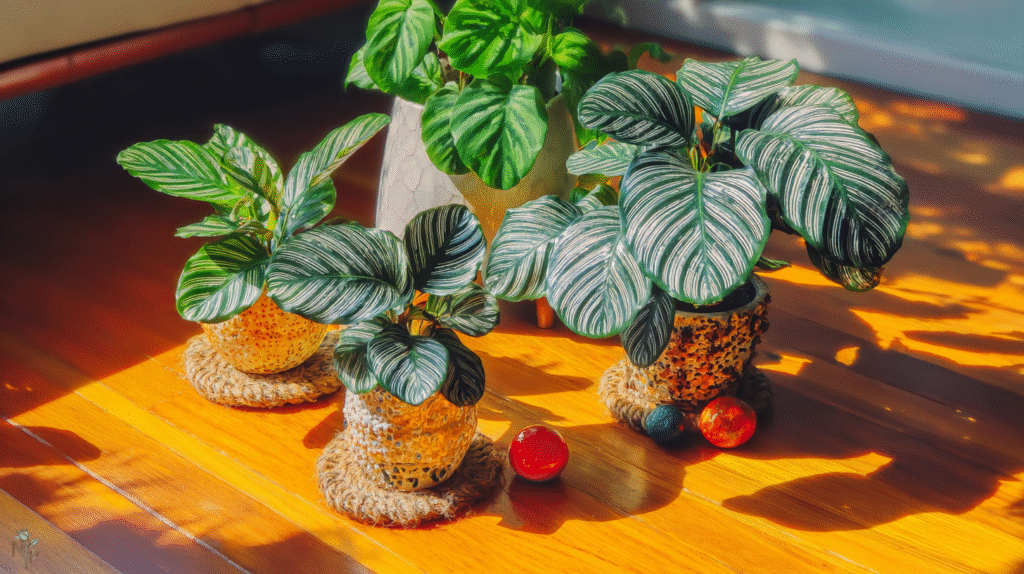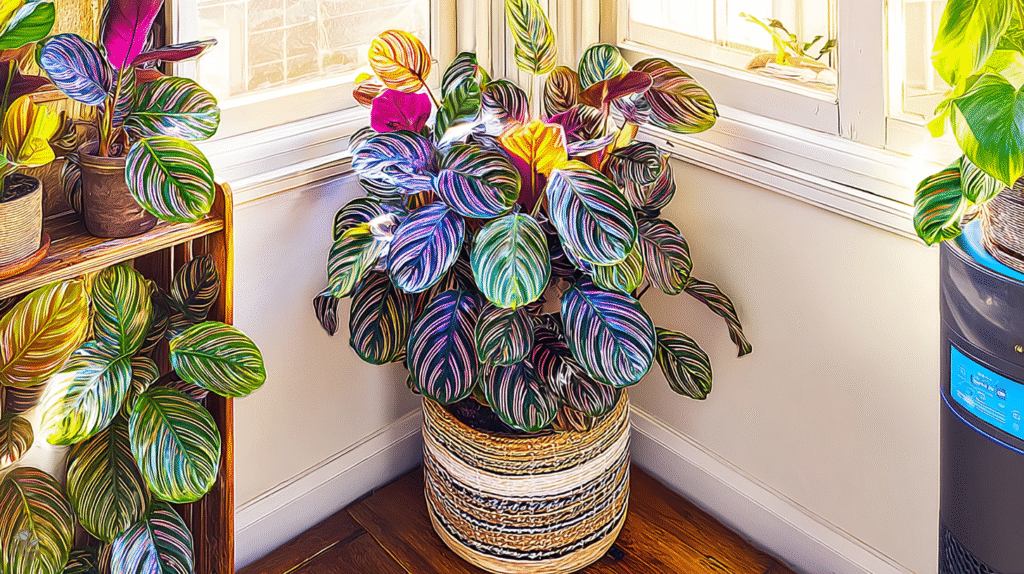My first Calathea lasted exactly 11 days. Bought it for $35 because the leaves looked like someone had painted them – purple undersides, green tops with pink stripes. By day five, the edges were brown. Day eight, leaves started curling like scrolls. Day 11, I threw a crispy plant corpse in the trash while googling “easiest houseplants” out of spite.
The tag said “low light, moderate water.” What it should’ve said was “requires rainforest conditions or will die dramatically while making you feel like a failure.”
Eight dead Calatheas and roughly $200 later (yeah, I have a problem), I finally cracked the code. Now I have six different varieties, including a White Fusion that everyone swears is impossible to keep alive and a Orbifolia with leaves bigger than dinner plates. They’re thriving, putting out new growth monthly, and doing that prayer plant thing where they fold up at night.
Here’s what nobody tells you: Calatheas aren’t hard if you understand they’re not houseplants trying to adapt to your home. They’re rainforest understory plants that happen to be imprisoned in your living room. Give them rainforest conditions and they’ll forgive your black thumb. Fight their nature and they’ll die out of spite

The Light Situation Is More Specific Than NASA Requirements
“Low light tolerant” is the biggest lie in plant care. What Calatheas actually want is bright, filtered, indirect light that never, ever includes actual sun rays touching their leaves.
What killed my first three:
North window, thought it was perfect “low light.” Plants grew one sad leaf in six months, then gave up. Too dark. Moved next one to south window, three feet back. Direct sun hit it for one hour. Leaves bleached white, then brown, then dead.
What actually works:
East window with sheer curtain. Gets bright morning light but filtered, never direct. My Calatheas here grow constantly. Or, north window IF it’s a big window and the plant is directly in it, not off to the side. My bathroom north window Calathea is happy, but it’s a huge window.
The meter that changed everything:
Bought a light meter for $15. Calatheas want 200-400 foot candles. My “bright” north window? 50 FC. My “perfect” spot three feet from south window? 800 FC at noon. No wonder everything died.
Now every Calathea spot reads 200-400 FC. Some are right in east windows, some are 6 feet from south windows, one’s under a grow light because that corner is cute but dark. The meter takes out guesswork.
Humidity: The Actual Make or Break Factor
This is what kills most Calatheas. They want 60-70% humidity minimum. Most houses in winter? 30%. Your Calathea isn’t dying from wrong watering or light – it’s dying from air drier than the Sahara.
What doesn’t work (I tried everything):
- Misting: Makes leaves wet, causes fungal spots, doesn’t raise humidity for more than 30 seconds
- Pebble trays: Raises humidity maybe 5% in a 2-inch radius. Useless.
- Grouping plants: Helps a little, maybe adds 10%, still not enough
The $30 solution that saved everything:
Humidifier. Not a cute desktop one – a proper 4-liter tank humidifier that runs constantly. Humidity in my plant corner went from 35% to 65%. Within a week, my Calatheas stopped getting crispy edges. Within a month, new growth everywhere.
Winter heating season? I run two humidifiers. Electric bill went up maybe $10/month. Worth it to not watch $35 plants die repeatedly.
The bathroom hack:
My bathroom Calathea (Rattlesnake) is my healthiest. Humidity from showers keeps it at 70-80%. Grows faster than all my living room ones despite getting less light. If you have a bathroom with any natural light, put a Calathea there.
The Prayer Movement That Freaks People Out
Nobody warned me Calatheas move. Like, visibly move throughout the day. First night, I thought my apartment was haunted. Leaves were horizontal at dinner, completely vertical by bedtime.
This is normal. They’re prayer plants – leaves go horizontal during day to catch light, vertical at night to conserve moisture. If yours isn’t moving, something’s wrong (usually light or humidity).
My White Fusion moves so dramatically that houseguests have asked if it’s real. The leaves literally rotate to track light throughout the day. Set up a time-lapse once – looks like the plant is dancing.

Watering: Where Everyone Screws Up
Calatheas want to be moist but not wet. Helpful, right? Like saying “cook until done.”
What this actually means:
Stick your finger in soil. Should feel like a wrung-out sponge – damp but not dripping. Never fully dry, never soggy. I check every 3-4 days, usually water weekly in summer, every 10 days in winter.
The water quality drama:
Tap water will eventually kill Calatheas. Not immediately, but slowly. Brown tips, then edges, then death. They hate fluoride, chlorine, and minerals. I use filtered water from a Brita pitcher. Some people insist on distilled. I’m not hauling distilled water for houseplants, Brita works fine.
Let water sit overnight to reach room temperature. Cold water shocks roots. Learned this when a Calathea dropped three leaves after watering with cold tap water.
Brown Tips and Crispy Edges (Everyone Gets Them)
If someone shows you a Calathea with zero brown tips, it’s either fake or they’re lying. Every Calathea gets some brown tips. It’s about minimizing, not eliminating.
Causes I’ve identified:
- Low humidity (main culprit): Under 50% = guaranteed brown
- Tap water: Fluoride and chlorine damage
- Dry soil: Even once causes damage
- Direct sun: Even 10 minutes
- Over-fertilizing: They’re light feeders
I trim brown tips with scissors sterilized with rubbing alcohol. Cut at an angle to look natural. My Calatheas all have trimmed tips. From three feet away, you can’t tell.
The Specific Varieties and Their Demands
Calathea Orbifolia:
Easiest one. Handles lower humidity (50%), bigger leaves mean fewer edges to brown. Gateway Calathea. Start here.
Calathea Medallion:
Medium difficulty. Wants 60% humidity minimum, very particular about water. Pretty enough to be worth the effort.
Calathea White Fusion:
Expert level. Wants 70% humidity or throws a tantrum. The white variegation means it needs more light than others but still no direct sun. I’ve killed two, third one is thriving next to the humidifier.
Calathea Rattlesnake:
Surprisingly easy. Handles 50% humidity, doesn’t crisp as fast. The one in my bathroom is huge.
Calathea Ornata (Pinstripe):
Drama queen. Perfect humidity and light or it drops leaves for fun. Mine survived but I don’t enjoy it.
The Fertilizer Situation
Calatheas are light feeders. I killed one by fertilizing weekly like my Pothos. Leaves got brown spots, new growth came out deformed.
Now I fertilize monthly in summer with quarter-strength liquid fertilizer. Half what the bottle says. Winter? Nothing. They’re barely growing anyway.
My Current Setup That Works
Living room corner:
- 4 Calatheas grouped together
- 6 feet from south window
- Humidifier running constantly (set to 65%)
- Light meter reads 250-350 FC
- All in plastic pots inside decorative pots (plastic holds moisture better)
Bathroom:
- 1 Rattlesnake Calathea
- North window, bright but no direct sun
- Humidity 70-80% from showers
- No humidifier needed
- Biggest, healthiest Calathea I own
Bedroom:
- 1 White Fusion
- East window with sheer curtain
- Small humidifier on nightstand
- Most demanding but most beautiful
Why I Keep Buying These Difficult Plants
Calatheas are objectively annoying. They need filtered water, specific light, constant humidity, and they’ll still get brown tips. But when you nail the conditions, they’re spectacular.
My Orbifolia leaves are 10 inches wide with patterns that look painted. The White Fusion looks like modern art. Watching them move throughout the day is weirdly calming. Plus, once you have the humidifier setup, they’re actually pretty low maintenance.

The Bottom Line
Calatheas want to live in a rainforest understory with 70% humidity, filtered light, and constant moisture. Your house is not that. But add a humidifier, find the right window, use filtered water, and they’ll adapt.
Start with an Orbifolia or Rattlesnake. Get a humidifier immediately (not negotiable). Use a light meter if you’re unsure about placement. Accept that some brown tips are normal. Don’t mist them no matter what the internet says.
Once you see a Calathea thriving – new growth unfurling, leaves moving daily, patterns vivid and clear – you’ll understand why people put up with their demands. They’re the supermodels of houseplants: high maintenance, slightly annoying, but absolutely gorgeous when conditions are right.






